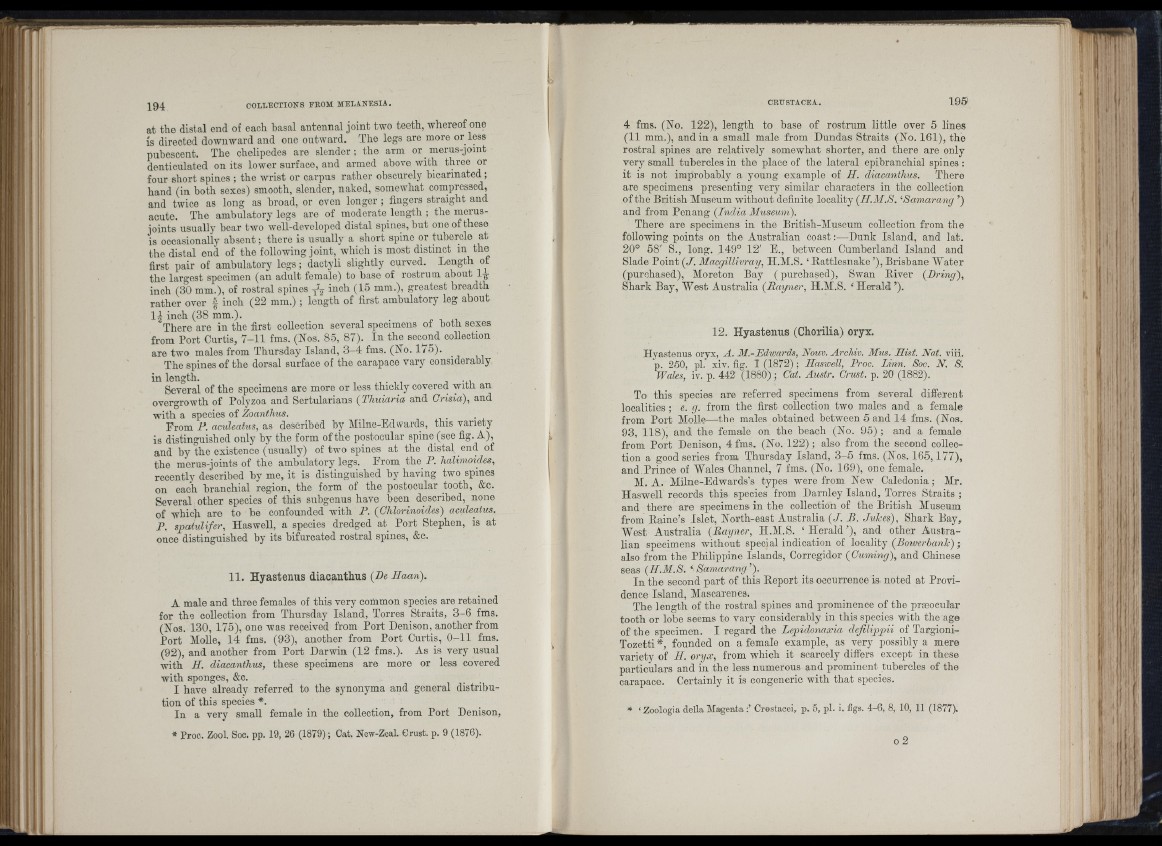
IBB
!S i
-- '1j
I ! ii
194 COLLECTIONS FEOM MELANESIA.
at the disi-al end of each basal antennal joint two teeth, whereof one
is directed downward and one outward. The legs are more or less
pubescent. The chelipedes are slender; the arm or_ merus-jomt
denticulated on its lower surface, and armed above with three or
four short spines ; the wrist or carpus rather obscurely hicarinated;
hand (in both sexes) smooth, slender, naked, somewhat compressed,
and twice as long as broad, or even longer ; fingers straight and
acute. The ambulatory legs are of moderate length ; the merus-
ioints usually hear two well-developed distal spines, but one of these
is occasionally absent; there is usually a short spine or tubercle at
the distal cud of the following joint, which is most distinct in the
first pair of ambulatory legs; dactyli slightly curved. Length of
the largest specimen (an adult female) to base of rostrum about 1-g-
inch (30 mm.), of rostral spines inch (15 mm.), greatest breadth
rather over inch (22 m m.); length of first ambulatory leg about
11 inch (38 mm.). .
There are in the first collection several specimens oi botb sexes
from Port Curtis, 7-11 fms. (Nos. 85, 87). In the second collection
are two males from Thursday Island, 3 -4 fms. (No. 175).
The spines of the dorsal surface of the carapace vary considerably
in length.
Several of the specimens are more or less thickly covered with an
overgrowth of Polyzoa and Sertularians (Thuiaria and Crisia), and
with a species of Zoanthus.
From P. aculeatus, as described by Alilne-Edwards, this variety
is distinguished only by the form of the postocular spine_(see fig. A),
a n d by the existence (usually) of two spines at the distal end of
the merus-joints of the ambulatory legs. Erom tho P. halimoides,
recently described by me, it is distinguished by having two spines
on each branchial region, the form of the postocular tooth, &c.
Several other species of this subgenus have been described, none
of which are to he confounded with P. (Chlorinoides) aculeatus.
P. spcdulifer, Haswell, a species dredged at Port Stephen, is at
once distinguished by its bifurcated rostral spines, &c.
I E ¿
f i
lïà !
11. Hyastenus diacanthus (De Haan).
A male and three females of this very common species are retained
for the collection from Thursday Island, Torres Straits, 3 -6 fms.
(Nos. 130, 175), one was received from Port Denison, another from
Port Molle, 14 fms. (93), another from Port Curtis, 0-11 fms.
(92), and another from Port Darwin (12 fms.). As is very usual
with H. diacanthus, these specimens are more or less covered
with sponges, &c.
I have already referred to the synonyma and general distribution
of this species *.
In a very small female in the collection, from Port Denison,
* Proe. Zool. Soc. pp. 19, 26 (1879); Cat. New-Zeal. Crust, p. 9 (1876).
CRUSTACEA. 195'
4 fms. (No. 122), length to base of rostrum little over 5 lines
(11 mm.), and in a small male from Dundas Straits (No. 161), the
rostral spines are relatively somewhat shorter, and there are only
very small tubercles in the place of the lateral epibranchial spines:
it is not improbably a young example of H. diacanthus. There
are specimens presenting very similar characters in the collection
of the British Museum without definite locality (H.M.S. ‘Samarang ’)
and from Penang (India Aluseum).
There are specimens in the British-Museum collection from the
following points on the Australian coast;—Dunk Island, and lat.
20° 58' S., long. 149° 12' E., between Cumberland Island and
Slade Point (J. Macgillivra.ir, H.M.S. ‘ Rattlesnake ’), Brisbane Water
(purchased), Moreton Bay ( purchased), Swan River (Dring),
Shark Bay, West Australia (Ragner, H.M.S. ‘ Herald. ’).
I ;
12. Hyastenus (Chorilia) oryx.
Hyastenus oryx, A. M.-Edivards, Nouv. Archiv. Mus. Hist. Nat. viii.
p. 250, pi. xiv. fig. I (1872) ; Hasivell, Proc. Linn. Soc. N. S.
Wales, iv. p. 442 (1880) ; Cat. Austr. Crust, p. 20 (1882).
To this species are referred specimens from several different
localities ; e. q. from the first coUection two males and a female
from Port Alolle—the males obtained between 5 and 14 fms. (Nos,
93, 118), and the female on the beach (No. 95) ; and a female
from Port Denison, 4 fms. (No. 122) ; also from the second collection
a good series from Thursday Island, 3 -5 fms. (Nos. 165,177),
and,Prince of Wales Channel, 7 fms. (No. 169), one female.
AI. A. Alilne-Edwards’s types were from New Caledonia; Air.
Haswell records this species from Darnley Island, Torres Straits ;
and there are specimens in the collection of the British Museum
from Paine’s Islet, North-east Australia (J. B . Jidces), Shark Ray,
West Australia (Baigner, H.Al.S. ‘ Herald ’), and other Australian
specimens without special indication of locality (Bowerbanh) ;
also from the Philippine Islands, Corregidor (Cuming), and Chinese
seas (H.M.S. ‘ Samarang’).
In the second part of this Report its occurrence is noted at Providence
Island, Alascarenes.
The length of the rostral spines and prominence of the præocular
tooth or lobe seems to vary considerably in this species with the age
of the specimen. I regard the Lepidonaxia dejilippii of Targioni-
Tozetti *, founded on a female example, as very possibly a mere
variety of H. oryx, from which it scarcely differs except in these
particulars and in the less numerous and prominent tubercles of the
carapace. Certainly it is congeneric with that species.
* ‘ Zoologia della Magenta Crostacei, p. 6, pi. i. figs. 4-6, 8, 10, 11 (1877).
o 2
M i ! l ! j
.... I
» r
'Hi 1
ft f Ii